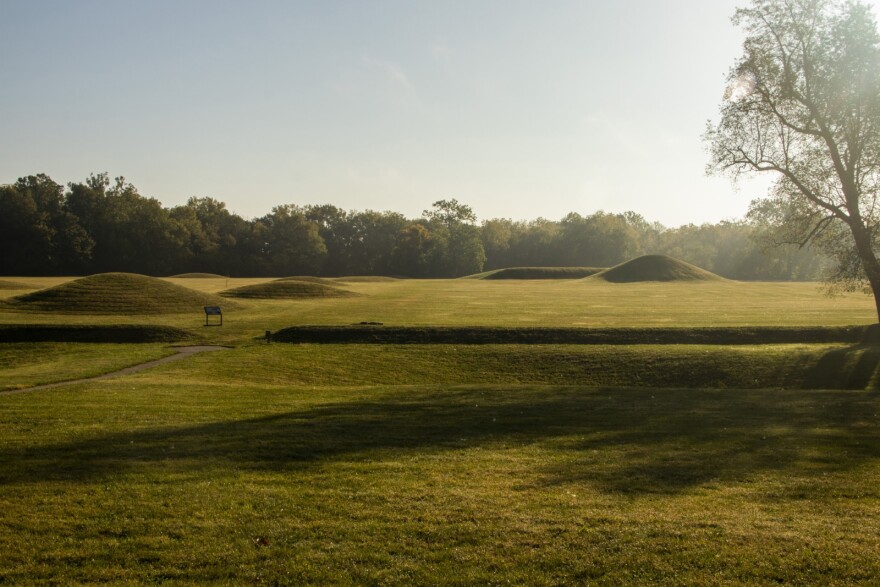Indigenous mounds and burial sites speckle Ohio’s landscape, from Miamisburg in the west to Marietta in the east.
These sites played important roles in many Indigenous cultures.
The Adena people built burial mounds as early as approximately 800 B.C. And the later Hopewell culture followed suit, in addition to building geometric mounds believed to be the sites of great ceremonial gatherings.
“The Hopewell, the Adena, the Fort Ancient peoples built great monuments of learning and expression, art, science, technology and astronomy,” said John Low, director of the Newark Earthworks Center and an enrolled citizen of the Pokagon Band of Potawatomi. “Many of those mounds and earthworks we see across Ohio today.”
Over centuries, these mound-building societies evolved into more recent Indigenous nations, including the Shawnee, Wyandot, Delaware, Miami, Ottawa and Seneca. Those people were forcibly removed from Ohio in the 19th century.
In their void, stories and harmful stereotypes about magic and “evil” Indigenous spirits connected to ancient burial grounds arose, perpetuated by tropes in film and pop culture.
“These are my ancestors' sites, but they are sites for all of humanity, too. And so I would hope that folks in Ohio, in the United States, and around the world come and visit these sites for what they are."John Low, director of the Newark Earthworks Center
In Ohio, myths about these sites abound.
A dorm at Ohio University, for example, is rumored to be built atop an Indigenous cemetery, whose spirits still haunt the building.
Then there’s the northeast Ohio village of Lodi. Some say the village’s haunted reputation stems from its founder, who allegedly removed Indigenous skeletons from their graves in order to build his home.
And if anyone disturbs the mound at Towner’s Woods near Akron, one legend says the guardian of a Hopewell princess will attack.
“[These] are other people's fantasies about my ancestors — Indian peoples — placed upon us by non-Native people,” Low said. “We didn't have princes and princesses. We didn’t have monarchies. It reflects generally the lack of knowledge of non-Native people about Native people.”
Low said these perceptions aren’t just misinformed, they can be harmful.
“It ‘others’ us,” he said. “It makes us strange and different and unlike people today, when in fact, [at this time] people were living lives around the world very similarly.
“We focus on the mounds and earthworks of American Indians around here as mysterious or indecipherable, fascinating and exotic. But I think it distracts from the fact that we were people just like everybody else, living in communities, having families, living sustainable lives in a good way.”
A hundred years ago, Low said perceptions of these mounds were very different.
“In the 19th century, of course, cemeteries were oftentimes considered places to picnic and be close to your deceased relatives,” he said.
Only relatively recently, in the 20th and 21st centuries, has that perception changed, and Low largely attributes that to representations of Indigenous burial grounds — along with cemeteries more generally — in books, movies and television shows.
“We are people who like to be scared,” he said. “It's fun to be scared to a point, and these are perfect places to present that ambience.”
However, he said, there are better ways to appreciate Ohio’s Indigenous past.
Just recently the Hopewell Ceremonial Earthworks were listed as a UNESCO World Heritage site, joining a list of places like the Taj Mahal, Great Wall of China, Stonehenge and Machu Picchu.
“The Ohio History connection has led the fight to celebrate these sites not as places that scare us or confuse us, but as places to celebrate,” Low said. “[These are] places that really exhibit the incredible ingenuity and achievements of humanity.
“These are my ancestors' sites, but they are sites for all of humanity, too. And so I would hope that folks in Ohio, in the United States, and around the world come and visit these sites for what they are. They are wonderful monuments of the Ohio River Valley.”


